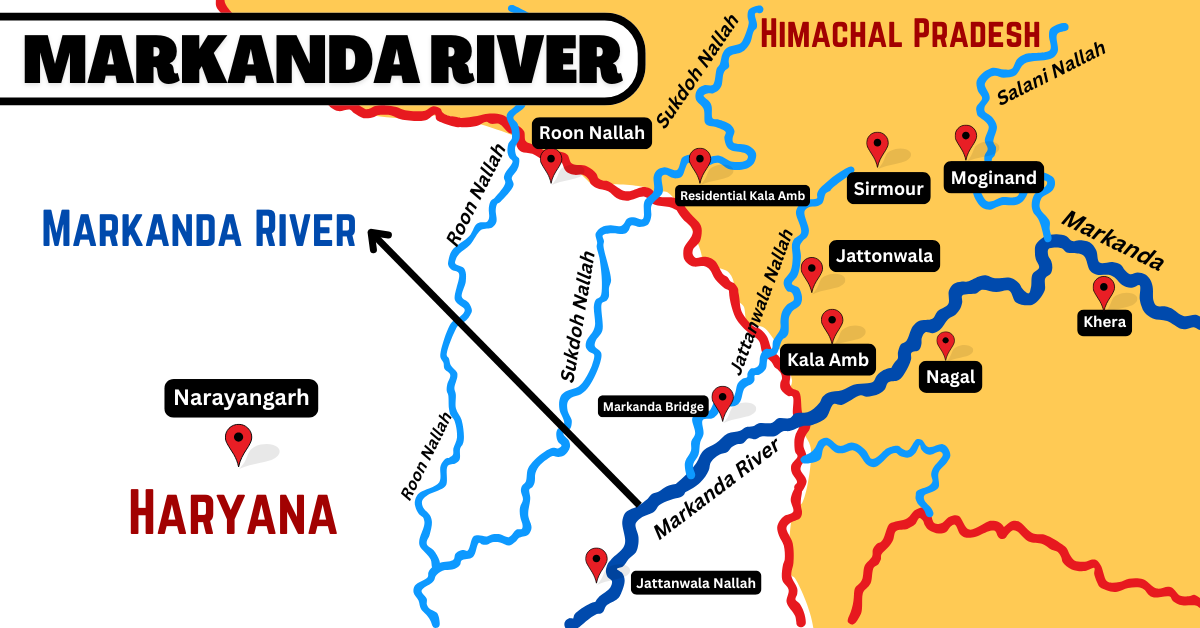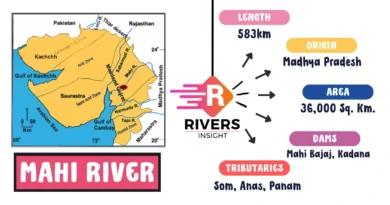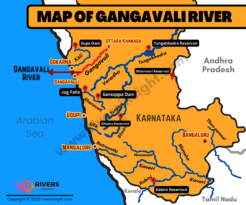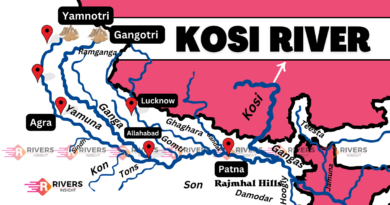Markanda River of Haryana with Map
Markanda River is a tributary of the Ghaggar River and is believed to be part of the ancient Vedic Saraswati River basin system. It originates in the Nahan region of Sirmaur district in Himachal Pradesh and covers 154 km with 24 km in Himachal Pradesh and 130 km in Haryana. Moreover, the Markandeshwar Temple, dedicated to Maharshi Markandeya, stands on its banks and holds great spiritual significance.
Table of Contents
Origin and Course of the Markanda River
The Markanda River originates in the Nahan area of Sirmaur district, Himachal Pradesh. It flows through Kala Amb, entering at Bikram Bag and exiting at Sadhora Bridge. The river then enters Haryana, covering 130 km before joining the Ghaggar River at Ismailabad.
Key Locations
- Nahan, Himachal Pradesh – Origin of the river.
- Kala Amb, Himachal Pradesh – The river enters this industrial town before moving into Haryana.
- Sadhora Bridge – The river exits Himachal Pradesh and enters Haryana.
- Shahabad Markanda, Haryana – Named after the river, known for religious significance.
- Ismailabad, Haryana – Confluence with the Ghaggar River.
The Markanda River Basin is divided into two parts:
- Khadir – Lower land prone to flooding.
- Bangar – Higher land that remains dry during the rainy season.
Historical and Religious Significance
The Markanda River was historically known as Aruna and is linked to the mythological Saraswati River. Some archaeologists believe that the Ghaggar-Hakra River, of which Markanda is a tributary, was once part of the Saraswati River, along which the Indus Valley Civilization flourished.
Key Spiritual Sites Near the River:
- Shahabad Markanda – Named after the river, known for religious and historical importance.
- Markandeshwar Mahadev Temple – Dedicated to Rishi Markandeya, after whom the river is named.
- Kurukshetra – A major pilgrimage site linked to the Mahabharata.
Tributaries of the Markanda River
The Markanda River Basin consists of several small seasonal streams, mainly from the Shivalik Hills, which contribute to its flow during the monsoon.
- Begna River
- Nakati River
- Ran River
- Salani Nallah
- Roon Nallah
- Sukdoh Nallah
Environmental Challenges
This Markanda River is facing serious environmental issues due to industrial waste and sewage. The biggest source of pollution is Jatta Wala Nallah, which carries waste from factories and sewage from Jattawala village. Another contributor is Salani Nallah, which brings some sewage from the Sirmaur Hills into the river.
Since the river is seasonal, it flows mainly during the monsoon and stays dry for most of the year. Heavy rainfall often leads to flash floods in Haryana, affecting homes and farms. Water contamination from industries and households has also reduced the river’s water quality, especially near Kala Amb. To protect the river, efforts are being made to control pollution, improve water conservation, and reduce industrial waste dumping.
So, this is all about Markanda River. If you have any thoughts, experiences, or questions about the Markanda River, feel free to share them in the comments below! We’d love to hear from you.
Thank You!




